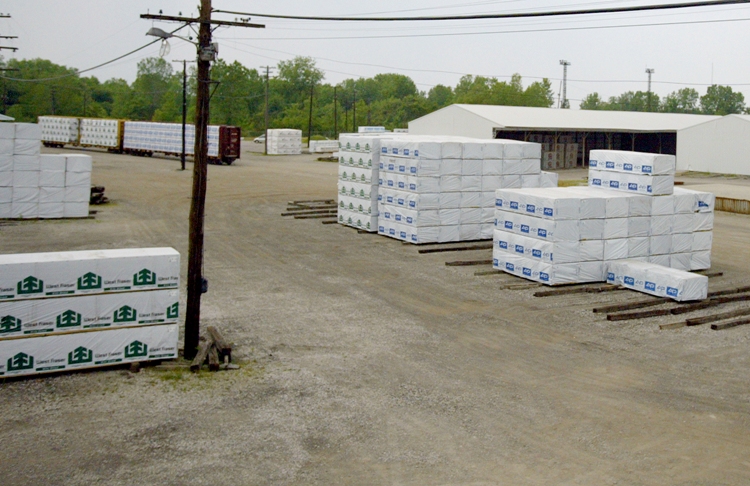The Perfect Storm - Part 5
Part 5: The Lumber Distribution Supply Chain
Photo courtesy Flickr user: onigiri-kun
The lumber distribution network, like most other construction dependent entities, was hammered during the housing recession. Thousands of companies went out of business during the downturn and unlike the producer side, very few of the wholesale distributors and lumber dealers who closed their doors are in a position to reopen facilities even though times are improving significantly. And although the lumber supply chain has experienced its share of hardships in the past this one has a different feel to it. Maybe its because we have lost so many independently owned operators who succumbed to the market’s competitive pressures or possibly its because years of consolidation have marginalized the strength of relationships that once seemed critical to the success of the process. Or, has the low-price mentality so embedded itself into the buyer’s decision making process that the margin for error is so razor-thin for the distribution network that their entrepreneurial spirit has all but evaporated from the once ultra-proud network. Regardless of the reason, somehow the entire system seems watered-down with fear, skepticism and indifference replacing flexibility, trust and mutual respect. But, then again, spending the last few years trying desperately to hang on to your business, your job, and your customers will make even the hardiest of souls a bit callous. In this issue of The Perfect Storm, we will examine lumber’s supply chain and trace how products move to market. We will look at distribution factors that helped facilitate this latest market run.
Most supply chain analysts probably look at the lumber distribution network that has been in place for more than half a century and purport the system is strangled with inefficiencies. Dr. Paul Teicholz, noted construction researcher and professor at Stanford University, claims that construction industry labor productivity is down nearly 25% over the past 40 years compared to labor productivity in non-farm industries like manufacturing which has increased well over 200%. His analysis in a nutshell: Too many players carry too much inventory to meet uncertain product demands that are poorly communicated. A little something for everyone it would seem.
Lumber’s distribution network consists of several levels and many categories of building material distributors each having their unique value-add in the supply chain. It is best described as a multi-step structure consisting of layers of “middlemen” who provide services in moving lumber products along the route to the jobsite. Or, as the popular UPS commercials elude to: That’s LOGISTICS! We have already tackled the first two steps in the chain, raw resource processing and lumber manufacturing. Now we must get the products developed and produced by manufacturers, to market. Most sawmills rely on some level of wholesale distributor to sell and move their goods. This can range from an asset-based wholesaler who takes title or possession of goods to a non-asset based distributor or office wholesaler, who assists manufacturers by buying production and shipping the product directly to retailers or other wholesalers.
Asset-based wholesale distributors, also known as mid-stage distributors or “2-steppers”, take inventory in bulk shipments (carloads, truckloads), store the materials and often break bulk and ship out smaller quantities to retail establishments. The value they provide include staging products closer to the marketplace fulfilling the just-in-time inventory mentality of the industry and making available less-than truckload quantities so retailers don’t have to sit on useless or slow turning wood. The non asset-based distributors, sometimes called traders or brokers, take large blocks of a mills regular production and arranges to ship the lumber in full carload or truckload volumes. Brokers operate on very small “pass through” margins as their overhead is relatively small and they do not have the capital investment of an asset-based wholesaler. This segment of the industry operates on a cash basis with payment typically made before materials ever reach the lumber dealers facility.
The next step in the distribution channel is the retail lumberyard level. These entities, also referred to as a pro-yards or dealers, exist to service the building contractor and home builder. They stock a broad array of products, perform some light manufacturing like truss and panel design and assembly, and provide just-in-time job site delivery as well as material returns. Material take-offs, credit terms and installed services are other functions retail dealers often provide.
For the sake of simplicity we won’t go into great detail about the variations that exist within the lumber supply chain. For instance, there are some retail lumberyards that have the ability, due to a number of compelling characteristics, to purchase directly from the mills. Normally at issue is that mills do not want to upset their volume distribution relationships for the relatively meager quantities a retail lumberyard can consume or the dealer just isn’t capable of stepping up and taking the large volumes the mill demands. There are also office wholesalers that will try and direct ship truckload commodity materials to job sites for large projects. But most end users find it problematic to store, manage, secure and prepay for such large quantities of lumber with few avenues to handle disputes. Also, certain building materials (windows, vinyl siding, etc…) have gravitated towards specialty distributors that act as a combination of wholesaler, dealer and even installer. These companies carry a narrow but well defined product offering that answers to specific needs of the contractor. Then of course, there is the home centers or big box outlets that cater to do-it-yourself homeowners and some specialty remodelers. Very few home builders or building contractors rely on home centers for their product needs regardless of the price leader mentality they have on specific commodity items. And, I haven’t mentioned reload centers, lumber futures, or buying groups, all of which play into the distribution of lumber products. It certainly gives us a myriad of story-lines as we look for future topics for our newsletter.
Even with all the consolidation and mergers that have taken place in lumber’s supply chain over the last decade the fundamental structure of the channels remains firmly in place. The segment players are well defined and their roles and value-adds are clear and while the supply chain is not terribly complicated it can get confusing because of the flexibility in getting products to market. There are many who clamor that the supply chain needs to desperately improve efficiency but with roughly 26,000 links in the marketplace that join manufacturers to the pro customer, it remains a very tall order.
Dealers were essentially living hand-to-mouth, somewhat spoiled by being able to reach out at any time and get whatever lumber they needed
There are several key distribution factors that I feel have contributed to the current market run. First of all, inventory levels, especially at the lumber dealer level, were exceptional low moving towards the end of 2012. Dealers were essentially living hand-to-mouth, somewhat spoiled by being able to reach out at any time and get whatever lumber they needed most often at a price that was equal to or lower than the last time they bought. They were also coming into a time of year when dealers traditionally reduce their inventory levels in preparation for taking physical inventory and in anticipation of winter buying opportunities. When the market started taking-off in November most dealers stayed on the sideline, not believing the market had this kind of potential upward pressure. Many have continued to buy only for their immediate needs and virtually none have taken significant inventory positions. This has continued to help fuel the market’s strength pushing out mill order files and draining distribution inventories. And, there is nothing on the horizon that makes anyone think this market is ready to head back the other direction.
Also, keep in mind that distributors and dealers alike have been hit with a real credit crunch. Regardless if you are a mom & pop outlet or a thousand unit national player, the financing landscape has changed and has significantly altered the ability of many in the chain to buy inventory. The downturn has left even some of the biggest names out there, very vulnerable and fragile. Their net worth really got hammered and it is impeding the way they want to do business coming out of the recession.
There has also been a fundamental change in buying/selling strategies that has the potential to increase volatility in the lumber market. More producers, especially OSB mills, have decided to increase contracted volumes for 2013. Dealers, worried about availability issues with key products are seeking to increase volumes on their contracts. The result is less lumber available to sell on the open-market which drives up open-market pricing and adds to overall pricing volatility.
Photo courtesy Flickr user: bulliver
Most of you can also appreciate the transportation challenges that our industry is faced with - just pull your vehicle into a gas station to be reminded. But obviously, a huge component to the cost of lumber is transportation related. Most lumber is transported by rail or truck. Rail has several obvious advantages in volume (roughly 3 semi trucks to a rail car) and can reduce some freight costs but reliability and timeliness can be suspect, especially if you are relying on just-in-time delivery. Eventually, lumber is going to find its way onto a truck, whether is coming across country or across town. The trucking industry is in the midst of its own turmoil right now. Aside from the obvious high fuel costs, tighter regulations are sidelining equipment and forcing drivers out of business. Also, a new federal safety rating program has caused a significant increase in trucking insurance rates driving freight rates even higher. Seems we can’t catch a break no matter which way we turn.
So, as you can see, the lumber distribution supply chain has no shortage of challenges to confront as lumber consumption escalates with the renewed strength of the housing market. It is important for everyone associated with the building industry to try and understand the best they can, what is going on in all segments that impact their business. Our hope with The Perfect Storm is to offer you credible information in order to help you base decisions and better communicate with your stakeholders. A position of strength always starts from a position of knowledge.
As always, Share your comments below on your experience with this volatile market and on the information in this article.
In our next addition, we will transition to the building contractor’s world to explore the challenges they face in a rising lumber market and examine how they are handling the obstacles that lie ahead.



